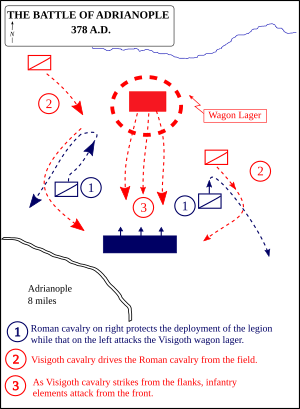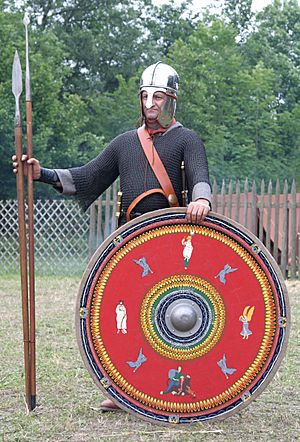Battle of Adrianople facts for kids
Quick facts for kids Battle of Adrianople |
|||||||
|---|---|---|---|---|---|---|---|
| Part of the Gothic War (376–382) | |||||||
 Map of the battle, according to the History Department of the US Military Academy |
|||||||
|
|||||||
| Belligerents | |||||||
| Goths Alans |
Eastern Roman Empire | ||||||
| Commanders and leaders | |||||||
| Fritigern Alatheus Saphrax |
Emperor Valens † Sebastianus † Victor Traianus † Ricomer |
||||||
| Strength | |||||||
| 20,000 | 30,000 | ||||||
| Casualties and losses | |||||||
| Unknown | 10,000–15,000or 20,000 (roughly two-thirds of the Roman force) killed | ||||||
The Battle of Adrianople was a huge battle fought on August 9, 378 AD. It was a major clash between the Eastern Roman Empire and a group of Goths and Alans led by a Gothic chief named Fritigern. The battle happened near a city called Adrianople in what is now Turkey.
This battle was a massive defeat for the Romans. Their emperor, Valens, was killed, and his army suffered terrible losses. Many historians see this battle as a key moment that started the decline of the Western Roman Empire. A writer named Ammianus Marcellinus wrote a detailed account of the battle from the Roman side.
Contents
Why the Battle Happened
Goths Settle in Roman Lands
In 376 AD, the Huns were invading lands in Europe. This forced many Goths, led by Alavivus and Fritigern, to seek safety. They asked the Roman Emperor Valens if they could settle inside the Eastern Roman Empire. Valens agreed, hoping they would become farmers and soldiers for the Empire.
However, once the Goths crossed the Danube River into Roman territory, some Roman commanders treated them very badly. They were dishonest and caused the Goths to suffer. Because of this unfair treatment, the Goths rebelled against the Romans.
Roman Reinforcements and Early Fights
Emperor Valens asked his nephew, Gratian, who was the Western Roman Emperor, for help. Gratian sent some troops and a general named Richomeres. For the next two years, there were many small battles between the Romans and the Goths. Neither side won a clear victory during this time.
In 378 AD, Valens decided to take charge himself. He gathered more soldiers from different parts of his empire, including Roman Syria and Roman Gaul.
Valens Prepares for Battle
Valens traveled from Antioch to Constantinople, arriving on May 30. He put a new general, Sebastianus, in charge of getting the Roman armies in Thrace ready. Sebastianus took 2,000 soldiers and marched towards Adrianople. On their way, they surprised and defeated some smaller groups of Goths.
Hearing about Sebastianus's success, Fritigern gathered his Gothic forces. Meanwhile, Gratian's army in the West was busy fighting another group called the Alamanni. After Gratian defeated them, his army started moving east to help Valens.
Valens was eager for his own victory. He moved his army closer to Adrianople. On August 6, his scouts reported that about 10,000 Goths were heading towards Adrianople. Valens prepared his camp by digging ditches and building walls.
Valens' Decision to Fight
Richomeres, Gratian's general, arrived at Adrianople with a letter. Gratian asked Valens to wait for his army to arrive before fighting the Goths. Valens' own officers also advised him to wait. However, Valens decided to fight without waiting. He believed his army was larger and he wanted to win a big victory on his own.
The Goths were also watching the Romans. On August 8, Fritigern sent a messenger to offer peace. He suggested an alliance in exchange for Roman land. Valens, confident in his numbers, turned down the offer. He didn't realize that a large part of the Gothic cavalry was away looking for food.
Roman Army at Adrianople
Valens' army had different types of soldiers. It included experienced fighters and units from various parts of the empire. The army had about seven legions, each with 700 to 1,000 men. These were mostly foot soldiers.
The Roman army also had cavalry, which were soldiers on horseback. These included mounted archers and the Scholae, who were the emperor's special guards. There were also some Arab cavalry, but they were better at quick attacks than big battles.
Roman Commanders and Units
Many important Roman officers were present.
- Ricimer (also known as Richomeres): A general from Gratian's army. He survived the battle.
- Sebastianus: A general who had recently arrived from Italy. He was killed in the battle.
- Victor: A cavalry general who advised Valens to wait for Gratian.
- Traianus: Another important general who died in the battle.
The army included units like the Lanciarii and Mattiarii, who were elite foot soldiers. There was also a group of Batavians, who were held in reserve.
How Many Roman Soldiers?
Historians have tried to guess how many soldiers Valens had. Some estimates suggest around 15,000 men, with about 10,000 foot soldiers and 5,000 cavalry. It's hard to know the exact numbers because records are not complete.
Gothic Forces
The Gothic forces were mainly made up of two large groups. One group was led by Fritigern, and the other by Alatheus and Saphrax. These groups included Goths and non-Gothic Alans.
The Gothic armies were mostly foot soldiers, but their cavalry played a very important role in the battle. Some older ideas suggested that the Goths won because they had many more soldiers or because their cavalry was much better. However, more recent studies suggest that the armies were similar in size. They also believe that the Gothic foot soldiers were more important than their cavalry, and that neither side used stirrups (which help riders stay on horses) at this time.
Ammianus Marcellinus, the historian, said that Roman scouts thought there were about 10,000 Goths. But he believed this was too low. Modern historians estimate the Gothic armies had between 12,000 and 15,000 fighters.
Where the Battle Took Place
The exact location of the battle is not known for sure, but it was close to the city of Adrianople. Historians have suggested a few possible spots, all within a few hours' march north or east of the city.
The Battle Begins
On the morning of August 9, Valens and his army left Adrianople. They marched about eight miles over difficult land to reach the Gothic camp, arriving around noon. The Roman soldiers were tired and thirsty.
The Goths had set up their camp on top of a hill, protecting their families and belongings inside a circle of wagons. Fritigern wanted to delay the Romans. He needed time for his Gothic cavalry, who were out looking for food, to return. The Goths also burned the fields to create smoke and make it harder for the Romans to advance.
Negotiations for peace began, but they mostly served to buy time for Fritigern. Some Roman soldiers, eager for revenge and thinking they had an easy win, started fighting without orders. A group of Roman archers attacked but were quickly pushed back because they didn't have enough support.
Gothic Cavalry Arrives
At this critical moment, the Gothic cavalry returned from their foraging trip. They charged into the battle, surrounding the Roman troops. The Romans were already disorganized from their first failed attack. They tried to retreat to the bottom of the hill, but their heavy armor and long shields made it hard to move.
The Roman army fell into chaos. Many soldiers were killed or exhausted. The Gothic cavalry continued their attack, and the killing lasted until nightfall.
The Emperor's Fate
During the chaos, Emperor Valens was left behind by his guards. His exact fate is unknown. Some believe he died on the battlefield, and his body was never found. Another story says he hid in a peasant's cottage with some guards. The Goths tried to loot the cottage, not knowing the emperor was inside. When Valens' men shot arrows from the cottage, the Goths set it on fire. Valens died in the flames.
What Happened After
Roman Losses and Impact
After their victory, the Goths immediately marched to Adrianople and tried to capture the city. However, they failed. Many Roman soldiers who had not been allowed into the city fought the Goths outside the walls.
The Battle of Adrianople was one of the worst defeats for the Roman Empire in a long time. About a third of the Roman army managed to escape, but the losses were huge. Many important officers, including General Sebastianus, were killed. This battle destroyed the core of the Eastern Roman army and many of its weapons and supplies. It also made it harder for the Romans to find new soldiers.
A New Era
Even though it was a terrible loss, the Battle of Adrianople did not end the Roman Empire. However, it showed that the "barbarian" groups, whether they fought for or against Rome, had become very powerful.
The Goths were never fully driven out or absorbed into the Roman Empire. They remained a distinct group within Roman borders, sometimes as allies, sometimes as enemies. The battle is often seen as a turning point, showing that heavy cavalry could defeat Roman infantry. However, some historians argue that the Gothic infantry was still the main force, and that the idea of medieval knights dominating warfare came much later.
Images for kids
See also
 In Spanish: Batalla de Adrianópolis para niños
In Spanish: Batalla de Adrianópolis para niños



